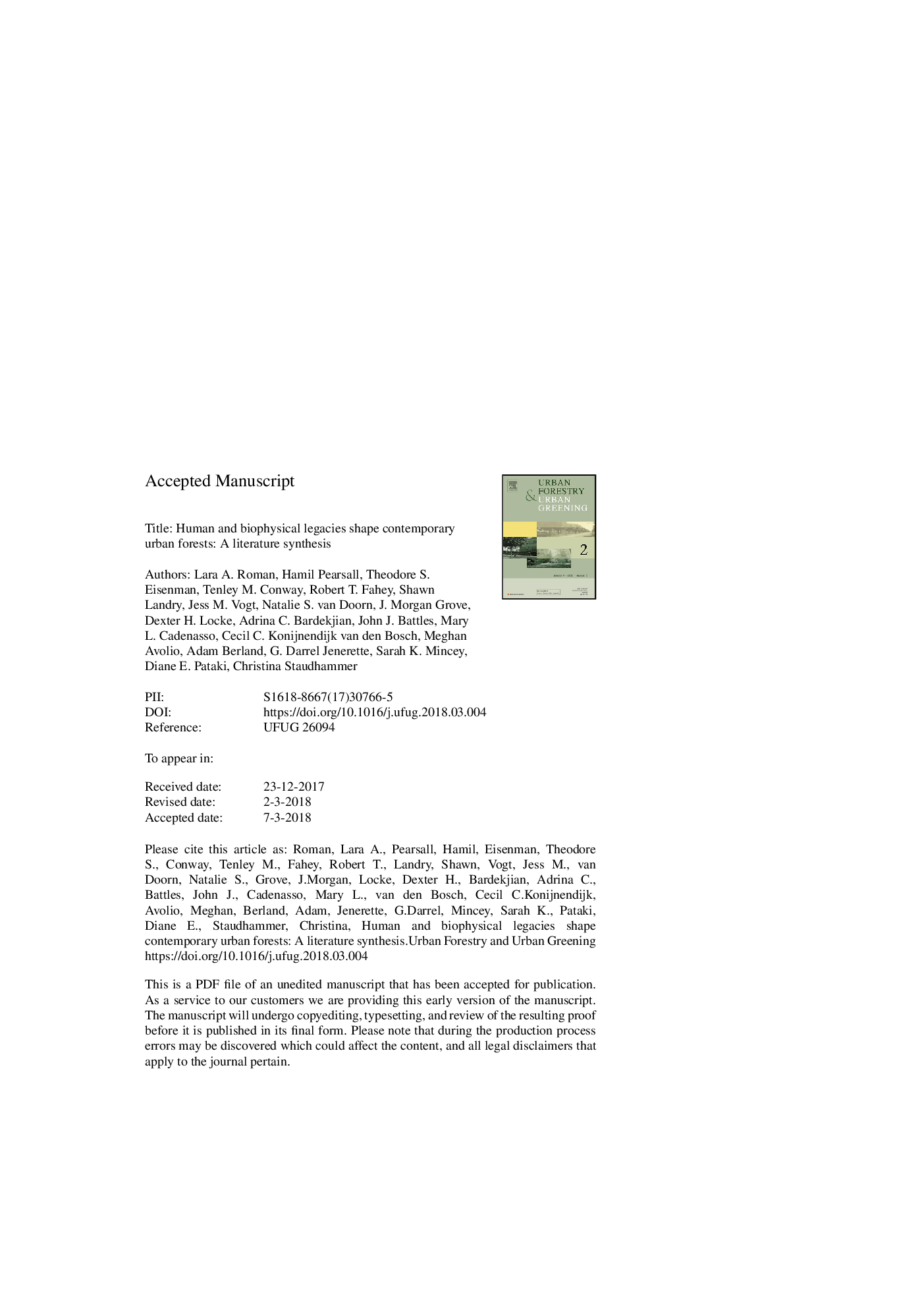| کد مقاله | کد نشریه | سال انتشار | مقاله انگلیسی | نسخه تمام متن |
|---|---|---|---|---|
| 6549188 | 1421859 | 2018 | 30 صفحه PDF | دانلود رایگان |
عنوان انگلیسی مقاله ISI
Human and biophysical legacies shape contemporary urban forests: A literature synthesis
ترجمه فارسی عنوان
بقایای انسانی و بیوفیزیک، جنگل های معاصر شهری را تشکیل می دهند: یک سنتز ادبی
دانلود مقاله + سفارش ترجمه
دانلود مقاله ISI انگلیسی
رایگان برای ایرانیان
کلمات کلیدی
ترجمه چکیده
درک اینکه چگونه جنگل های شهری الگوهای فعلی خود را پوشش می دهند، ترکیب گونه ها و تنوع درختان، نیاز به ارزیابی اثرات تاریخی تاریخی دارند. با این حال، تجزیه و تحلیل ویژگی های فعلی جنگل های شهری اغلب به عوامل اقتصادی-اجتماعی معاصر محدود می شود و نقش تاریخ را در بر می گیرد. مؤسسات، جوامع انسانی و شرایط بیوفیزیکی شهرها با گذشت زمان تغییر می کنند، لایه هایی از میراث را در منظر ایجاد می کنند، تغییرات جنگل های شهری را از طریق فرایندهای پیچیده تعاملی و بازخورد ها می دهند. فضاهای سبز شهری و درختان کاشته می تواند به مدت طولانی پس از استقرار آنها ادامه یابد، به این معنی که تاج و تخت بالغ امروز، شرایط و تصمیمات سال های قبل را نشان می دهد. در این مقاله سنتز، ما در مورد برخی از رانندگان اصلی تاریخی انسان و بیوفیزیکی و مفاهیم مرتبط با میراث بیان شده در الگوهای جنگل شهری حاضر، با نشان دادن نمونه هایی در ایالات متحده و کانادا بحث می کنیم. زمینه زیست محیطی - بیوم بومی، آب و هوا، توپوگرافی، پوشش گیاهی اولیه و استفاده از اراضی قبل از شهرنشینی - نشان دهنده شرایط اولیه ای است که در آن شهر ایجاد و رشد می کند و این زمینه بر تاثیرات میراث تأثیر می گذارد. رانندگان انسانی اثرات میراث می توانند دوره های تاریخی خاصی را بازگو کنند: تاریخ استعماری مربوط به نمادگرایی گونه های خاص، پارک های شهری و جنبش های زیبایی شهری. سایر رانندگان انسانی شامل پدیده هایی می شوند که در دوره های زمانی مختلف مانند شکل شهری شهری و تغییرات اجتماعی و اقتصادی قرار می گیرند. اثرات مادی بیوفیزیکی شامل عواقب ناشی از اختلالات گذشته مانند وقایع شدید آب و هوا و آفات آفات و بیماری ها می شود. متخصصان درخت شهری نقش مهمی در بسیاری از اثرات میراثی بوسیله میانجیگری و بازخورد بین رانندگان بیوفیزیکی و انسان دارند. ما بر اهمیت دیدگاه های تاریخی تاکید می کنیم تا رانندگان قدیمی که الگوهای جنگل شهری فعلی را تولید کرده اند، مورد تحقیق قرار گیرند و از روش تحقیقاتی میان رشته ای و ترکیبی استفاده کنند تا مکانیسم تغییرات جنگل های بلندمدت شهر را در مقیاس های داخلی و بین شهر باز کنند.
موضوعات مرتبط
علوم زیستی و بیوفناوری
علوم کشاورزی و بیولوژیک
جنگلداری
چکیده انگلیسی
Understanding how urban forests developed their current patterns of tree canopy cover, species composition, and diversity requires an appreciation of historical legacy effects. However, analyses of current urban forest characteristics are often limited to contemporary socioeconomic factors, overlooking the role of history. The institutions, human communities, and biophysical conditions of cities change over time, creating layers of legacies on the landscape, shifting urban forests through complex interactive processes and feedbacks. Urban green spaces and planted trees can persist long after their establishment, meaning that today's mature canopy reflects conditions and decisions from many years prior. In this synthesis article, we discuss some of the major historical human and biophysical drivers and associated legacy effects expressed in present urban forest patterns, highlighting examples in the United States and Canada. The bioregional context - native biome, climate, topography, initial vegetation, and pre-urbanization land use - represents the initial conditions in which a city established and grew, and this context influences how legacy effects unfold. Human drivers of legacy effects can reflect specific historical periods: colonial histories related to the symbolism of certain species, and the urban parks and civic beautification movements. Other human drivers include phenomena that cut across time periods such as neighborhood urban form and socioeconomic change. Biophysical legacy effects include the consequences of past disturbances such as extreme weather events and pest and disease outbreaks. Urban tree professionals play a major role in many legacy effects by mediating the interactions and feedbacks between biophysical and human drivers. We emphasize the importance of historical perspectives to understand past drivers that have produced current urban forest patterns, and call for interdisciplinary and mixed methods research to unpack the mechanisms of long-term urban forest change at intra- and inter-city scales.
ناشر
Database: Elsevier - ScienceDirect (ساینس دایرکت)
Journal: Urban Forestry & Urban Greening - Volume 31, April 2018, Pages 157-168
Journal: Urban Forestry & Urban Greening - Volume 31, April 2018, Pages 157-168
نویسندگان
Lara A. Roman, Hamil Pearsall, Theodore S. Eisenman, Tenley M. Conway, Robert T. Fahey, Shawn Landry, Jess Vogt, Natalie S. van Doorn, J. Morgan Grove, Dexter H. Locke, Adrina C. Bardekjian, John J. Battles, Mary L. Cadenasso,
